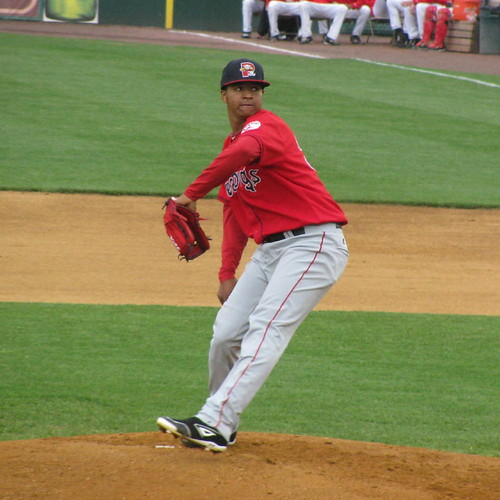 Maybe his stats didn’t exactly jump off the proverbial page. But the Boston Red Sox obviously rated right-hander Stolmy Pimentel (who turned 21 on February 1) so highly that they placed him on their 40-man roster during the offseason. Otherwise, they ran the risk of losing him in the annual Rule 5 draft which is held in December, even though he had yet to pitch above Class A.
Maybe his stats didn’t exactly jump off the proverbial page. But the Boston Red Sox obviously rated right-hander Stolmy Pimentel (who turned 21 on February 1) so highly that they placed him on their 40-man roster during the offseason. Otherwise, they ran the risk of losing him in the annual Rule 5 draft which is held in December, even though he had yet to pitch above Class A.
Boston followed the same route with left-hander Felix Doubront when they placed him on their 40-man roster two years ago when he was 21. If they had not, it would have been a foregone conclusion that he would have been scooped up in the Rule 5 draft.
Pimentel, who pitched last season for High-A Salem (the loftiest level he had attained in his four-year pro career), was 9-11 in 26 starts, replete with a 4.06 ERA and 102 strikeouts as compared with 42 walks in 129 innings.
Interestingly, Pimentel’s stuff resembles that of 2010 American League All-Star Clay Buchholz.
Pimentel’s four-seam fastball usually tops out in the low-to-mid 90s and it serves as an ideal set-up pitch for what’s rated as a plus curveball, along with a changeup that’s also in the same neighborhood.
“I remember one game I saw him pitch in last May,” said an American League scout referring to a game against Myrtle Beach during which Pimentel tossed six perfect innings and struck out four in the process. “When he was on the mound, he showed me he had the presence of a major league pitcher. You could see it in front of your eyes that this kid has a chance to make it to the major leagues.”
Perhaps. But that possibility may be at least a couple of years in the future.
Speaking of “the future,” Pimentel was tabbed to pitch in the 2010 Major League All-Star Futures Game. He only raced two batters, but he retired them both -– the Florida Marlins’ Logan Morrison and the Washington Nationals’ Danny Espinosa.
Each of those two players finished the season in the major leagues and are now important parts of each team’s lineup.
Pimentel’s fastball is considered to have good riding life which, as mentioned above, sets up his swing-and-miss changeup.
The consensus is he needs to stay on top of his curveball more in order to be consistent but he has improved its break and velocity over the 2009 and 2010 seasons.
Yet through games of May 20, a lack of consistency has plagued Pimentel, who despite his tender years was bumped up to Portland by the Red Sox.
In his first seven starts, Pimentel was 0-5 with a 6.19 ERA.
“To me, there’s very little difference in the way his arm works between his fastball and changeup,” said the scout. “There’s a lot of deception because of his arm speed. He has what I rate as a quick arm and a quick hand when he throws his changeup. In addition, a lot of times it dives.
“His changeup has a chance to develop into a plus pitch at the major league level. For a kid as young as he is, for him to have a feel like that for that pitch is both rare and impressive.”
Pimentel (who received $25,000 when he signed out of the Dominican Republic as a 16-year-old) was 3-0 with a 2.90 ERA in 13 starts during his first season (2007) of pro ball, with the Gulf Coast Red Sox. He also allowed 44 hits in 42 innings -– but he struck out 60.
He finished with a career-low WHIP of 1.065 and was voted into the Dominican Summer League All-Star Game.
Pimentel was bumped up a level in 2008, to rookie league ball at Lowell and continued to progress. In 11 starts, he was 5-2 with a 3.14 ERA. The youngster continued to impress in 2009, when he was moved up to low-A Greenville. In 24 games (23 starts), he was 10-7 with a 3.82 ERA and an impressive 102 strikeouts replete with only 29 walks in 118 innings.
Understandably, his strikeout ratio (7.9 whiffs per nine innings pitched) was nearly as impressive as his walk ratio (2.2 freebies per nine innings). At the risk of stating the obvious, what that indicated was Pimentel threw an inordinate number of pitches in the strike zone.
Granted he completed the 2010 season with his first sub-.500 record as a starter and a career-high ERA. But given his stuff and level of maturity, using stats as the only barometer would be a mistake -– one reason being the move from low-A ball to high-A ball is more difficult that one would believe.
Then, there’s the matter of his physical condition.
“He’s about 6-foot-3 and 190 pounds, and did a better job of staying in good condition last season,” said the scout. “As a result, it helped him maintain the velocity on his fastball deeper into his starts.
“But also consider this. Given his age, he can put on a few more pounds which could add another foot to his fastball. The kid’s aggressive and you have to love the way he throws strikes and gets ahead in the count.”
However, that was last year and so far this year getting ahead in the count has been a problem.
